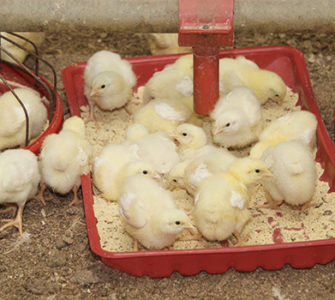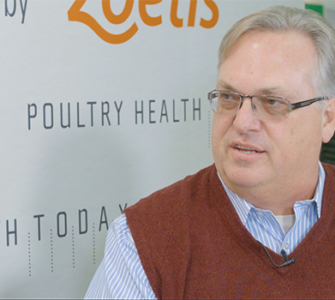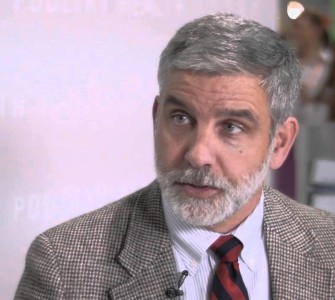Antibiotic-free broiler production requires a paradigm shift
Producers, veterinarians and nutritionists agree that antibiotic-free broiler production in the U.S. will place greater emphasis on farm management and nutrition.
By Terrence O’Keefe
Chick-fil-A’s February 2014 announcement that the quick service restaurant chain will serve only chicken raised without antibiotics at its restaurants within five years has heightened interest in management programs for broilers that can make antibiotic-free (ABF) production of poultry in the U.S. economical. A roundtable discussion, among poultry producers, veterinarians and nutritionists, at Alltech’s International Poultry Forum, examined steps that can be taken to make antibiotic-free poultry production as efficient as possible.

Seeding chicks with a competitive exclusion product or a direct-fed microbial can provide the chicks with beneficial microbes.
How to succeed in ABF broiler production
The question of how to succeed with antibiotic-free production was posed to the entire audience and responses were solicited from a wide variety of attendees from several different countries and disciplines.
The first point agreed upon is that the term antibiotic-free broiler production doesn’t mean the same thing in all countries. A European producer said the ban on the use of so-called growth-promoting antibiotics has not restricted the use of ionophore coccidiostats. He said that the ionophores have been helpful not just for controlling coccidiosis, but also for the antibacterial affect that they have in the gut of the bird.
The definition of what constitutes antibiotic-free broiler production in the U.S. has evolved. The USDA considers ionophores to be antibiotics as well as anticoccidials, so they are not allowed to be used in growing programs for birds that will be labeled as “raised without antibiotics.” According to industry sources, Chick-fil-A’s antibiotic-free standards will not allow for the use of chemical coccidiostats/coccidiocides of any kind.
Changing the paradigm of poultry production
There was consensus in the discussion on one major point: There isn’t any one thing that you can substitute for antibiotics and just keep doing everything else the way you have in the past. Dr. Stephen Collett, associate professor, College of Veterinary Medicine, University of Georgia, said it succinctly, “You don’t want an alternative to antibiotics, you want to change the paradigm and change the way you feed and raise the birds.”
Another area of agreement from members of the audience was that antibiotic-free broiler production requires growers to be better managers and that management of the gut microflora is extremely important. One producer in Brazil said that U.S. producers will have trouble with antibiotic-free poultry production on built-up litter, because of the carryover of the microflora in the house from flock to flock, but there was not universal agreement on this point.
The statement was made that good antibiotic-free broiler production starts with the breeders. Because broiler parent stock is maintained during lay on restricted feeding programs, the gut microflora of the hens is not ideal. Microflora from the hen is vertically transmitted to the chick on the shell of the egg and in the embryo itself. It was suggested that seeding the chicks with a competitive exclusion product or a direct-fed microbial can provide the chicks with beneficial microbes and give them the chance to establish a healthy mature gut flora earlier in their lives. One member of the audience reported that farms with poor performance tended to benefit most from probiotics.
Nutritional changes for ABF production
Ingredient quality was said to be of even greater importance in rations made for antibiotic-free programs. Some in the audience suggested that all-vegetable diets with enzyme inclusion to aid digestion of the non-starch polysaccharide portion of the ration were important.
“We are not feeding chickens anymore, we are feeding an ecosystem,” said Dr. Peter Ferket, nutritionist, North Carolina State university. He said that increasing the particle size of some of the corn in the diet had a big impact on feed conversion and on the gut microflora. He said that there is a lot to learn on this topic, but some of this isn’t expensive to implement.
A broiler producer in Ireland with experience in antibiotic-free production said it is looking at particle size in the diet, and that it might have an impact on digestibility of the ration and also impair the growth of bad bacteria. This producer said it can still use ionophores and that the use of antibiotics for treatment of disease has increased in Europe with the ban on the use of growth-promoting antibiotics.
Microflora in the ceca
Variability of particle size has an impact on digestion and feed conversion. Very fine particle size causes quick passage of feed through the gut. Experiments have shown that varying the size of pieces of corn in the diet can have a big impact on feed conversion. Collett, who presented at Alltech’s Symposium in addition to commenting at the roundtable discussion, said, “We don’t know what the ideal particle size is.”
The ceca of the bird is important for absorbing water and for digestion of the indigestible fraction of the feed by gut microbes.
Collett said that what is needed is a low nutrient density in the feed residual that makes it to the ceca. Coccidiosis causes more rapid passage of feed nutrients through the digestive tract and results in higher nutrient density in the lower gut, which can feed harmful microbes like Clostridium perfringens. The pH of the ceca is also important and plays a role in whether certain types of bacteria proliferate rapidly, and this can be determined by the quantity of the indigestible portion of the feed that makes it to the ceca.
Collett said that establishing and maintaining a normal beneficial microflora in meat bird flocks begins on the breeder farm. He said that broiler breeders have a microflora based on the restricted feeding program they live under. The breeder hens’ microflora is what is on the egg shell and is what the chicks start out with.
The chicks bring the microflora of the hen with them from the hatchery but then are exposed to the microflora of prior flocks when they arrive at the farm. Collett said that what you end one flock with, you start out with for the next flock. In this manner, he said it takes more than one flock to change the microflora of a broiler house, and this means positive results from management changes may take a few flocks to be fully realized.
Coccidiosis control and antibiotic-free production
In Europe, so-called antibiotic-free poultry production may include the use of chemical coccidiostats, but in the U.S. antibiotic-free poultry production generally means the use of a coccidiosis vaccine. Collett said, “Coccidiosis vaccination is really controlled exposure.”
With vaccination, birds are exposed to live coccidia from drug-sensitive strains at hatch. This gives the birds the coccidiosis challenge earlier in their life than when exposure occurs later in the poultry house. He said that the impact of the bird’s immune response at an earlier age is less costly in terms of lost performance than if the exposure occurs later. Vaccination shifts the peak challenge from four weeks after placement to two weeks.
Collett said that contrary to what many in the poultry industry think, antibiotic-free production doesn’t have to cost more. He cited two examples of North American turkey producers who have antibiotic-free programs, yet are still in the top 25 percent of turkey producers in Agri Stats for cost per pound. Both producers feed an all-vegetable diet.
A turkey producer in Canada uses a coccidiosis vaccine, while a U.S. producer uses neither a coccidiosis vaccine nor a traditional coccidiostat. The U.S. producer uses a natural product which is a combination essential oils and plant and yeast extracts as part its coccidiosis control program.
Collett said that both of these turkey producers employ what he calls a seed, feed and weed program. The seed portion is a probiotic culture, the feed is an organic acid treatment and enzymes, and the weed phase includes essential oils and yeast cell wall products.
Article courtesy of Watt Global Media.
Posted on November 4, 2014

















